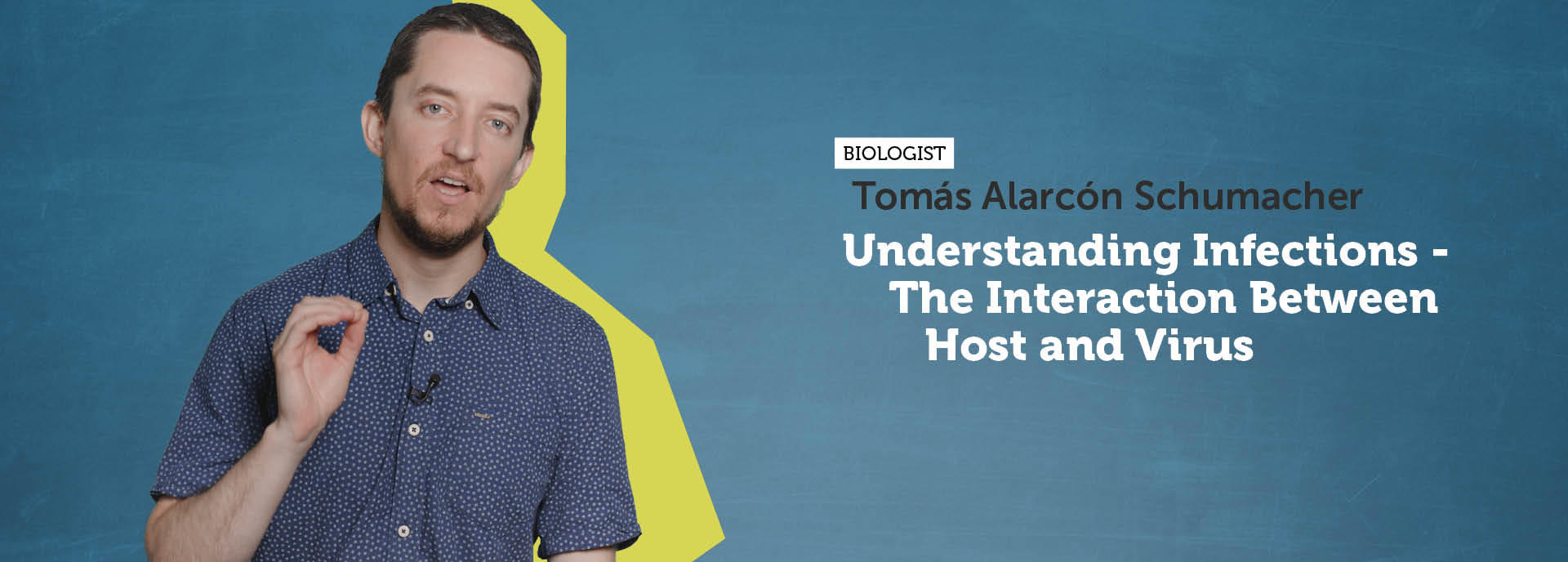How Can the Toxic Effects of Chemical Compounds on Humans Be Predicted by Means of Crowdsourcing?
As humans react differently to chemical substances one of the challenges for public health is to establish which compounds are harmful for whom. The research project presented in this video uses crowdsourcing as part of the DREAM challenges as a method to improve research on this topic by involving the scientific community. Data on different reactions to chemical compounds were shared with scientists all over the world. [...] Watch video
Streptococcus pneumoniae kills millions of people worldwide. For the subgroup serotype 8, prevalent in the United States and Western Europe, there is no vaccine to date. In this video, PETER H. SEEBERGER explains the approach of his research group to create a synthetic sugar vaccine against this bacterial infection that works in mice. They relied on synthetic chemistry to assemble sugar chains from monomers; the [...] Watch video
How Can the Enantiomers of a Chiral Molecule be Separated More Effectively?
Chiral molecules are molecules that behave as image and mirror image to each other; these are also called enantiomers. There is a demand in pure enantiomers, which can be created for the use of a variety of industries, such as drugs for the pharmaceutical industry or herbicides for agrochemistry. ANDREAS SEIDEL-MORGENSTERN and his research team investigate access to these pure enantiomers. To achieve this, they work on [...] Watch video
How Can We Experimentally Determine Why Hydrogen Atoms Are Absorbed on Metal Surfaces?
Although very light weight, hydrogen atoms have a high probability to be absorbed by a metal surface upon collision. In this video, OLIVER BÜNERMANN explains collision experiments carried out to determine why this is the case. During the experiment, they shot a hydrogen atom beam at a gold surface and at an insulator, measured the speed and direction of the atoms bouncing back from each surface and compared the results. [...] Watch video
The accumulation of carbon dioxide (CO2) in the Earth’s atmosphere is responsible for one of the most pressing problems of our age, global warming. In this video, SUSAN TRUMBORE analyses the key role that plant and soil systems play in the carbon cycle in order to better understand how they can assist us in combating this issue. Trumbore explains how Carbon-14 (or radiocarbon), a byproduct of atmospheric weapons testing [...] Watch video
It has been heretofore understood that patterns of cloudiness are controlled by large scale weather systems. In this video, BJORN STEVENS challenges this orthodoxy, arguing that small and intermediate scales of motion play a key role in determining the Earth’s cloudiness. Using aircraft to measure the vigor of intermediate scales of motion and groups of scientists to examinesmall scale patterning, Stevens identifies [...] Watch video
The Arctic sea ice is the ice that is floating on the Arctic Ocean. In recent decades, this pack ice has been disappearing very rapidly. So the question arises when the Arctic sea ice will be completely gone. DIRK NOTZ has examined this using the Arctic summer sea ice in September as example. As he explains in this video, his research group combined satellite observations with model simulations and found a clear linear [...] Watch video
Why and How Do Plants Emit Volatile Compounds When Defending Themselves Against Herbivores?
Plants have at least two ways of defending themselves against herbivores. They can do so directly by producing toxins or compounds that are anti-digestive, or they can indirectly defend themselves by emitting volatile compounds that attract predators and parasitoids of the herbivores. MEREDITH SCHUMANN investigates these indirect defenses. As she explains in this video, there are both fast and slow components to [...] Watch video
Our planet’s cloudiness has been heretofore understood as being controlled by the slowly varying, large scale, atmospheric circulation known as the Hadley cell. In this video, CLAUDIA STEPHAN argues that this model is overly simplistic. Bringing recent measurements taken over the Atlantic into dialogue with observational data gathered in Darwin on gravity waves, Stephan suggests that relationships between clouds and [...] Watch video
To What Extent Do Aerosol Particles in the Atmosphere Mask the Effects of Greenhouse Gases?
Since the rise of industrialization more and more greenhouse gases are being emitted into the atmosphere and as a result the earth’s climate is warming. It is known that part of the temperature rise is balanced by aerosol particles in the atmosphere – partly also emitted by human activity. The extent of that balancing however is unknown. As BJORN B. STEVENS explains in this video, the researchers used a new approach [...] Watch video
The Earth system is unique and highly complex, presenting a daunting challenge to researchers that seek to model and understand it. Noting that existing approaches seem unable to arrive at reliable predictions for the implications of CO2 emissions, in this video, MARKUS REICHSTEIN proposes that new methodologies incorporating machine learning and artificial intelligence be brought to bear on the problem. Identifying [...] Watch video
Rainfall has a large impact on how life functions on earth and this, in turn, has great implications for both the ecosystem and human well-being. The research presented in this video investigates the ways in which the pollution of the air system affects the working of clouds and how they produce rain. By measuring the aerosol particles in clouds in specific areas, MEINRAT O. ANDREAE explains, the research team discovered [...] Watch video
Neutrophils are both the most abundant immune cells and the first to go to a site of infection. In this video, ARTURO ZYCHLINSKY explores the role that Neutrophils play in infectious disease. Zychlinsky explains that Neutrophil Extracellular Traps (or NETs) kill and prevent the dissemination of microbes while also alerting other parts of the immune system to infection. Revealing some of the processes involved in NET [...] Watch video
How Does the Interaction of Water with Collagen Lead to Pretension in Our Connective Tissues?
The connective tissues in our body – such as skin, tendon, or bones – all contain a molecule called collagen. When you cut your skin, it springs open. This shows that the tissues in our body are under pretension. The research presented in this video is interested in the question of whether the interaction of collagen with water causes this tension. The researchers found, as PETER FRATZL explains, that the pretension [...] Watch video
KAI SUNDMACHER’s aim is to introduce a more sustainable process to chemicals production. As he explains in this video, for new technological developments in chemical process engineering a new methodology is needed that is able to include many decision variables in order to find the best pathway from the raw materials to the target product. Therefore, his research team developed an elementary process function (EPF) [...] Watch video
In electronic devices, material imperfections play a key role in determining lifespan as well as in safety considerations. In this video, CHRISTIAN LIEBSCHER puts such defects under the microscope so that we can better understand their atomic structure. Focusing on grain boundaries at which different crystals join together and using transmission electron microscopy, Liebscher explains how this research can bring about [...] Watch video
Plants use certain chemical compounds to defend themselves against animals that feed on them. As JONATHAN GERSHENZON explains in this video, dandelions are a very good model to research the defences of plants because they are especially robust. The research team therefore investigated dandelions to identify the compound that protects the roots from being damaged by insects. They studied dandelions from different regions [...] Watch video
The study presented in this video evaluates data from observational towers, satellite pictures and other published data to compare the impact of land-cover change and land management change on climate. The results show that land management change within the same vegetation (e.g., harvesting a formerly untouched forest) has effects on climate change that are similarly large as effects of land-cover change (e.g., changing [...] Watch video
Mankind is increasingly polluting the atmosphere across the planet. The research detailed in this video is interested in the questions of how this pollution is generated and how it affects the health of people. The investigators found, as JOS LELIEVELD explains, that air pollution leads to millions of premature deaths since it causes, for instance, fatal cerebrovascular and respiratory diseases. The researchers also [...] Watch video
How Can Waste Be Converted Into a Source of Carbon for the Production of Chemicals?
Currently, the petrochemical industry uses fossil fuels as the source of carbon for the production of many things, including plastics. This is problematic because carbon dioxide adds to climate change and, in addition, fossil fuels are running out. Therefore, LARGUS ANGENENT and his research group are looking for new sources of carbon. As he explains in this video, their aim is to convert waste into the chemicals needed [...] Watch video
The Eurasian forests are an important component in the earth’s climate system: Forests contain a lot of carbon in the vegetation and in the soil. But their role under warming conditions is still unclear – on the one hand, a higher CO2 level in the air acts like a fertilizer for plants that grow and thus store more CO2 in the [...] Watch video



























